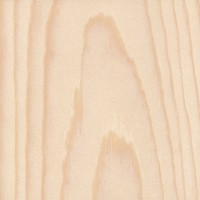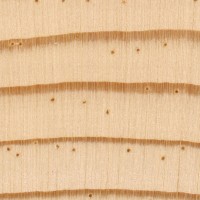 |
Common Name(s): Ponderosa Pine
Scientific Name: Pinus ponderosa Distribution: Western North America Tree Size: 100-165 ft (30-50 m) tall, 2-4 ft (.6-1.2 m) trunk diameter Average Dried Weight: 28 lbs/ft3 (450 kg/m3) Specific Gravity (Basic, 12% MC): .38, .45 Janka Hardness: 460 lbf (2,050 N) Modulus of Rupture: 9,400 lbf/in2 (64.8 MPa) Elastic Modulus: 1,290,000 lbf/in2 (8.90 GPa) Crushing Strength: 5,320 lbf/in2 (36.7 MPa) Shrinkage:Radial: 3.9%, Tangential: 6.2%, Volumetric: 9.7%, T/R Ratio: 1.6 |
Color/Appearance: Heartwood is reddish brown, sapwood is yellowish white.
Grain/Texture: Straight grained with medium texture.
Endgrain: Medium-large resin canals, numerous and evenly distributed, mostly solitary; earlywood to latewood transition fairly abrupt, color contrast can vary depending on growth ring spacing; tracheid diameter medium-large.
Rot Resistance: The heartwood is rated as moderate to low in decay resistance.
Workability: Ponderosa pine works well with both hand and machine tools. Glues and finishes well.
Odor: Ponderosa Pine has a faint, resinous odor while being worked.
Allergies/Toxicity: Working with pine has been reported to cause allergic skin reactions and/or asthma-like symptoms in some people. See the articles Wood Allergies and Toxicity and Wood Dust Safety for more information.
Pricing/Availability: Ponderosa Pine has a very wide distribution throughout western North America, and is one of the most important lumber species in the western United States. It should be widely available as construction lumber for a modest price. Some Ponderosa Pine is mixed with Lodgepole Pine and sold together as construction lumber under the stamp “PP/LP”.
Sustainability: This wood species is not listed in the CITES Appendices, and is reported by the IUCN as being a species of least concern.
Common Uses: Veneer, plywood, sheathing, subflooring, boxes, crates, posts/poles, interior trim, cabinetry, and construction lumber.
Comments: Although Ponderosa Pine is technically classified as a yellow (hard) pine, it shares many characteristics with white (soft) pines, having a considerably lower density than the yellow pine species found in the eastern United States.
The city of Flagstaff, Arizona was named for a flagpole made of Ponderosa Pine that was used to raise a United States flag (then 37 stars) during a centennial ceremony on July 4, 1876.
- Austrian Pine (Pinus nigra)
- Caribbean Pine (Pinus caribaea)
- Eastern White Pine (Pinus strobus)
- Jack Pine (Pinus banksiana)
- Jeffrey Pine (Pinus jeffreyi)
- Khasi Pine (Pinus kesiya)
- Limber Pine (Pinus flexilis)
- Loblolly Pine (Pinus taeda)
- Lodgepole Pine (Pinus contorta)
- Longleaf Pine (Pinus palustris)
- Maritime Pine (Pinus pinaster)
- Ocote Pine (Pinus oocarpa)
- Patula Pine (Pinus patula)
- Pinyon Pine (Pinus edulis)
- Pitch Pine (Pinus rigida)
- Pond Pine (Pinus serotina)
- Radiata Pine (Pinus radiata)
- Red Pine (Pinus resinosa)
- Sand Pine (Pinus clausa)
- Scots Pine (Pinus sylvestris)
- Shortleaf Pine (Pinus echinata)
- Slash Pine (Pinus elliottii)
- Spruce Pine (Pinus glabra)
- Sugar Pine (Pinus lambertiana)
- Sumatran Pine (Pinus merkusii)
- Table Mountain Pine (Pinus pungens)
- Western White Pine (Pinus monticola)
- Virginia Pine (Pinus virginiana)
 |
 |
 |
 |




